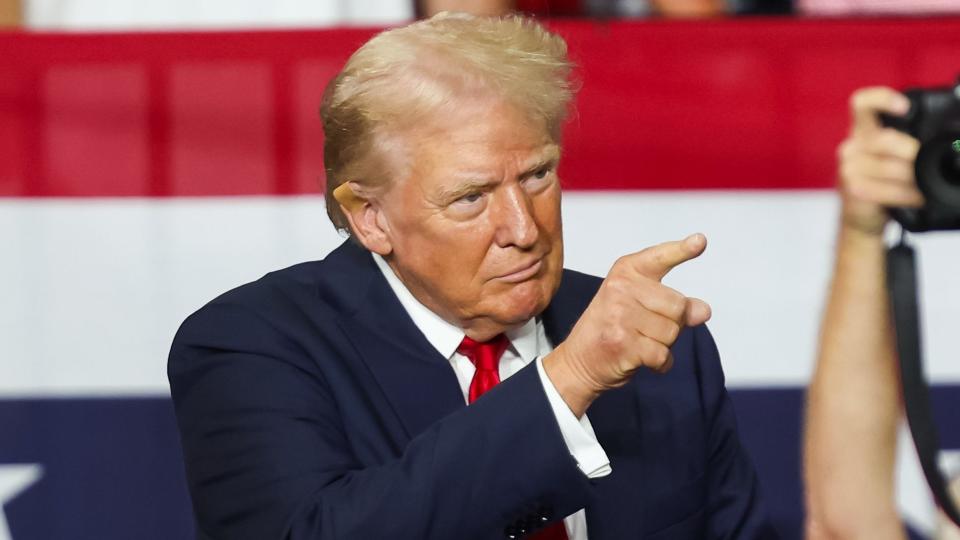What a Trump Win Could Mean for Middle-Class Taxes

Regardless of your political beliefs, as a middle-class taxpayer, it always pays to keep an eye on potentially market-moving events and a shift in the White House always carries ramifications.
If former President Donald Trump returns to the White House, changes in tax policy could directly affect the wallets of Americans, making it one of the most important issues to monitor both as an investor and a middle-class taxpayer. Generally speaking, a Trump presidency is expected to be more tax-friendly to corporations and individuals, but that’s not a blanket truth across the board.
Check Out: Trump Wants To Eliminate Income Taxes: Here’s What That Would Mean for the Economy and Your Wallet
Find Out: 6 Money Moves You Must Make if You Want to Be Like the Wealthy
Of course, trying to predict the exact tax policies that a president will enact can often be a fool’s errand. For starters, candidates will often toss out many ideas while trying to get elected that may or may not come to fruition. Even those that are intended to be definite policy changes may still need Congressional approval, which is never guaranteed.
That being said, here are some of the tax policies that Trump supported during his first term or has discussed as potential options in the current campaign cycle.
Also see how the rich could be affected.
Earning passive income doesn't need to be difficult. You can start this week.
Cut to Federal Payroll Taxes
Payroll taxes are used to fund federal programs such as Social Security and Medicare. They amount to 7.65% of a worker’s income, with a matching 7.65% paid by employers on behalf of employees. Those who are self-employed must unfortunately bear the brunt of both the employer and the employee’s share, amounting to a whopping 15.30%.
Learn More: I’m an Economist: Here’s What a Trump Win in November Would Mean for the Tax Burden on the Poor
Trump has long toyed with the idea of cutting federal payroll taxes. During the coronavirus pandemic, his administration proposed eliminating federal payroll taxes through the end of 2020, with the potential to remove them permanently after that. In the end, he was only able to garner a temporary deferral of payroll taxes, but it appears to still be on his mind in 2024.
These cuts would significantly lower the tax burden on all Americans, including the middle class, but how they would affect programs like Social Security and Medicare going forward remains to be seen.
Extension of TCJA Cuts
Trump hasn’t been shy about touting the benefits of his 2017 tax cuts, and he’ll likely fight hard to get them extended if he is elected. The provisions of the TCJA are set to expire in 2025, which would be the first year of Trump’s second term if he regains the White House. Thus, extending those tax cuts, even in a modified fashion, likely will be one of his first priorities if he returns for a second term.
Other Policies
Trump hasn’t been particularly clear about other tax proposals he might want to enact as of July 2024. If he were to win an extension of the 2017 tax cuts, it would mean the standard deduction would remain at elevated levels, rather than being rolled back — something that could help the middle class. Other policies Trump has floated but that may or may not be priorities include:
Replacing personal income taxes with increased tariffs
Exempting tip income from taxation
As Election Day approaches, it is likely that various tax proposals will be tossed out by the former president. Some may likely become official policy if he is elected, while others may simply be political rhetoric.
Possible Republican Pushback?
Republicans are noted for their desire to cut taxes, but they also tend to fight against large increases to the deficit, at least publicly. One of the most costly provisions of 2017’s TCJA was the 20% deduction of business profits for certain “pass-through” entities such as sole proprietorships or partnerships. While enacted in an effort to boost small businesses, it’s estimated that the provision will cost $700 billion over 10 years.
According to Benjamin Page, senior fellow at the Tax Policy Institute, more than 50% of the benefits of that tax cut accrue to the top 1% of earners, making it politically unpopular in certain circles. Thus, this is just one example of a Trump tax cut that may potentially be on the chopping block.
Overall, the Congressional Budget Office estimated that the 2017 tax cuts boosted the federal deficit by $2 trillion over 10 years. But Trump seems more inclined to continue, increase or extend tax cuts rather than shrink the deficit directly. Whether this puts him at odds with his fellow Republicans if he reclaims the White House remains to be seen.
Editor’s note on election coverage: GOBankingRates is nonpartisan and strives to cover all aspects of the economy objectively and present balanced reports on politically focused finance stories. You can find more coverage of this topic on GOBankingRates.com.
More From GOBankingRates
7 Reasons A Financial Advisor Could Boost Your Savings in 2024
I'm an Economist: Here's My Prediction for Social Security If Kamala Harris Wins the Election
The 6 Most Harmful Myths About Debt -- and The Surprising Reality
This article originally appeared on GOBankingRates.com: What a Trump Win Could Mean for Middle-Class Taxes

 Yahoo Finance
Yahoo Finance 